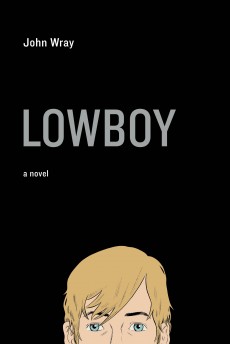 Reviewed:
Reviewed:
Lowboy by John Wray
Farrar, Straus and Giroux, 272 pp., $25.00
William Heller is on a mission. It is his duty — in his head, anyway — to save the warming world before it ends as a ball of fire within a matter of hours. “To cool down the air, I have to cool myself down first,” he explains. Thankfully, he knows just what to do to keep the world from incinerating: he needs to get laid.
In his third novel, John Wray tells the story of William, a 16-year-old paranoid schizophrenic off his meds and on the loose in New York City. Lowboy is the nickname of our addled hero (“Because I get moody . . . Also because I like trains”). The novel that bears his name is a 24-hour chase, with chapters toggling between his adventures and those of his pursuers: Ali Lateef, a methodical middle-aged detective, and Yda “Violet” Heller, Lowboy’s unsettlingly beautiful mother. As Lowboy trawls the city’s underground labyrinth, his mother and Lateef search for him in a self-conscious duet of fact-finding and flirtation.
This is a very different sort of book from Wray’s first two. With The Right Hand of Sleep and then Canaan’s Tongue, he proved his talent and fearlessness. He set complicated characters in remote eras (the Austrian countryside before the Second World War and the American south during the Civil War, respectively), and delivered rich works of storytelling. Those evocative books, with their poetic language and classic sensibility, earned praise and awards, yet precious few readers. Lowboy feels like an effort to fix that.
Having shrugged off the intimidating gravitas of historical fiction, Wray has embraced the present, the local, the hip. Like many other relatively young authors who get noticed (Wray is 38), his gaze has turned to the New York City of the moment, a place of Dr. Zizmor ads, cupcake fetishists, and underground graffiti tags that ooze “like toothpaste from a tube.” Despite such subjects as mental illness and apocalyptic visions, this is a fairly light book, a snapshot of city living through a lens of psychosis.
Although told in the third person, the book begins in Lowboy’s “cramped and claustrophobic brain” as he fidgets and muses on a train. He has just escaped his official minders by leaping into a subway car just before the doors close:
He got on board the train and laughed. Signs and tells were around him. The floor was shivering and ticking beneath his feet and the bricktiled arches above the train beat the murmurings of the crowd into copper and aluminum foil. Every seat in the car had a person in it. Notes of music rang out as the doors closed behind him: C# then A. Sharp against both ears, like the tip of a pencil.
The setting is as banal as a morning commute, but Wray has injected some art and warp. Some of the book’s freshest moments involve Lowboy’s skewed, deteriorating perception of events as the last traces of his antipsychotic cocktail (Zyprexa, Depakote) exit his system. On a subway platform he notices that the “argon lights were stuttering like pigeons. There was some kind of intelligence behind them.” An enormous homeless crack addict he befriends takes his hand, which “seemed miniature compared to hers, tiny and white, a bird’s egg cradled in a wooden spoon.”
Lowboy’s delirium in some ways captures the deliriousness of the city. He is amazed by what we are too dulled to find amazing anymore: the sound and feel of a subway train, the shopping bags “hanging like vampire bats from the trees.” Yet his language – weird and detached – starts to wear. The problem is not just that his thoughts are often impenetrable and nonsensical (albeit prescient at times, like all good naive heroes), but that his actions aren’t clearly motivated. A section in which Lowboy reconnects with a young woman from his past first captures the sweet thrill of teenage yearning. But then something happens and all is lost, owing to his crumbling, distorting mind. We don’t really know why Lowboy does most of what he does, which means that we don’t always care.
The problem is nearly the opposite in the scenes with Lateef and Violet. Their charged exchanges are littered with just a bit too much omniscience – we jump from his head to hers, his anxieties to hers, all of it conceivable yet rendered with a heavy hand. Lateef is a likable character, a missing persons detective “of solitary pleasures” whose “tastes ran to 78-rpm records, statesmen’s autobiographies, and single-malt Scotch.” But in the company of Violet, an ethereal, foreign beauty in orthopedic shoes, he’s a little awkward. He finds himself too charmed by this remote, carelessly attractive woman, and ends up feeling like a clumsy suitor in their de facto partnership. Violet is a more cryptic character, but we still get too much of her own droning inner monologue, her concerns that she’s unsympathetic, “like someone auditioning badly for a role.” We aren’t given the chance to observe and deduce; we have to constantly hear what they are thinking. The result is greater sympathy for Lowboy’s condition: as a schizophrenic, he has to hear such chatter all the time.
The novel features some satisfying suspense, and Wray occasionally crafts sentences so lovely that they demand to be reread. (“The sun was declining and the firepits were glowing and oilcolored nightbirds were warbling down from the trees.”) But on balance this novel is an underwhelming showcase of Wray’s talents. Readers drawn by the seductive cover and sensational subject will hopefully consider his backlist; the rest of us will wait patiently for his next one.
Emily Bobrow is editor of More Intelligent Life, and a contributor to the Books and Arts section of The Economist.
Books mentioned in this review:
Lowboy
Canaan’s Tongue
The Right Hand of Sleep

